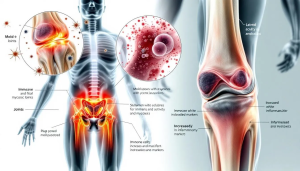Yes, mold toxicity can mold toxicity cause joint pain. Microscopic spores released by mold can easily infiltrate indoor environments and contribute to health risks, including joint pain. When mold releases harmful mycotoxins, your body’s immune system reacts, leading to inflammation that often affects the joints. This inflammation can result in ongoing pain and discomfort. In this article, we’ll delve into how mold exposure impacts the body, what symptoms to watch for, and ways to manage and prevent joint pain caused by mold.
Key Takeaways
Mold exposure can lead to inflammation and joint pain due to mycotoxins triggering the immune response, affecting multiple body systems.
Chronic inflammation from mold exposure exacerbates symptoms like joint pain, stiffness, and fatigue, impacting the quality of life.
Effective management requires reducing mold exposure, recognizing symptoms early, and seeking professional treatment for mold-related health issues.
How Mold Exposure Affects the Body
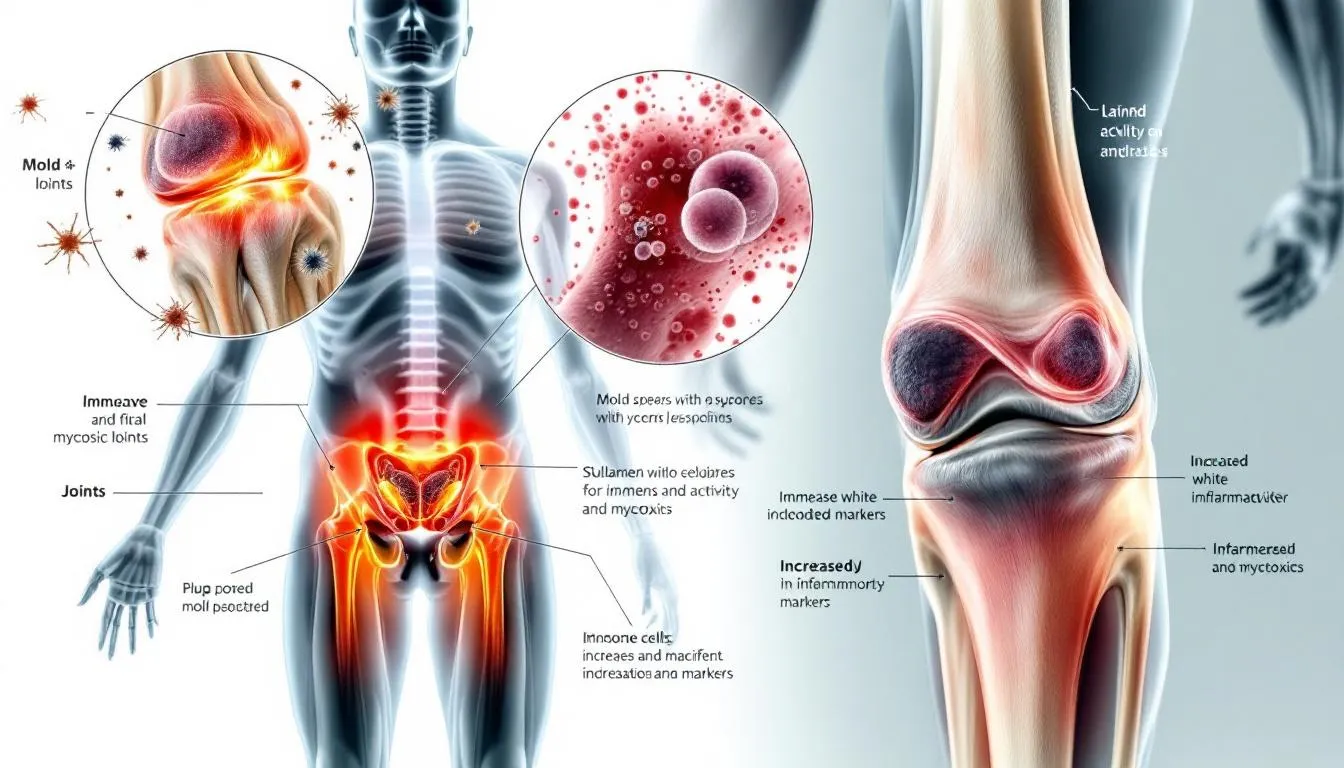
Mold exposure is a significant health concern that can impact multiple systems within the body. These effects are primarily due to mycotoxins, harmful compounds, including toxic compounds, released by molds that thrive in damp, poorly ventilated environments. Mold grows in indoor environments such as homes, schools, and workplaces, especially where moisture is present. Mold grows particularly in areas with water damage or poor maintenance, which increases the risk of exposure. Mycotoxins can enter the body through inhalation or skin contact, making exposure common in areas with toxic mold growth.
Once inside the body, mycotoxins produced trigger immune responses that can lead to inflammation, affecting various tissues and organs. Mold allergies are a common result of exposure, often causing symptoms like sneezing and itchy eyes. One of the key areas impacted by this inflammation is the joints, where persistent exposure can cause significant pain and discomfort. This immune response is the body’s way of trying to combat the foreign substances introduced by mold, but it often results in uncomfortable and sometimes debilitating symptoms.
The respiratory system is particularly vulnerable to mold spores, which can exacerbate conditions like asthma and allergies. However, the impact of mold exposure extends beyond the lungs, affecting the nervous system, central nervous system, skin, and even brain function. The body’s immune system plays a crucial role in managing these mycotoxins, but chronic exposure can overwhelm the system, leading to ongoing health issues.
Inflammatory Response to Mold Toxins
When the body encounters mold toxins, the body’s inflammatory response is triggered to neutralize these harmful substances. This inflammation can affect:
muscles
joints
connective tissues leading to persistent discomfort and pain. Individuals exposed to mold often report:
muscle aches
joint pain
generalized discomfort, highlighting the widespread impact of this inflammatory response.
Inflammation triggered by mold exposure is not limited to the joints. It can also affect other parts of the body, resulting in a range of symptoms from mild discomfort to severe pain. This systemic inflammation can manifest as painful joints and muscle aches, making daily activities challenging and reducing the quality of life.
For those struggling with mold-related joint pain, it is essential to recognize the symptoms and seek appropriate treatment. Reducing inflammation through medical intervention and lifestyle changes can significantly improve overall well-being. Awareness of the body’s inflammatory response to mold toxins is the first step towards managing and alleviating these symptoms.
Joint Pain as a Symptom of Mold Toxicity

Joint pain is one of the more debilitating symptoms of mold toxicity. The mycotoxins released by mold can irritate tissues, causing persistent pain and discomfort that can be difficult to manage. Swelling, stiffness, and discomfort in the joints are common symptoms experienced by those exposed to joint pain mold exposure.
In some cases, mold exposure can contribute to chronic pain conditions such as fibromyalgia. The persistent joint pain and muscle aches can significantly impact daily life, making it crucial to identify the source of the pain and seek appropriate treatment. Common signs of mold-related joint pain include persistent pain, swelling, and morning stiffness, which can indicate an inflammatory response to mold mycotoxins. Sinus congestion is another frequent symptom experienced by those exposed to mold, often accompanying joint pain and other allergy-like symptoms.
Recognizing the link between mold exposure and joint pain is essential for effective treatment. Key steps include:
Addressing the root cause of the pain—mold toxicity—to find relief and improve quality of life.
Undertaking mold remediation.
Reducing exposure to mold spores to manage joint pain and prevent further health issues.
Chronic Inflammation and Mold Exposure
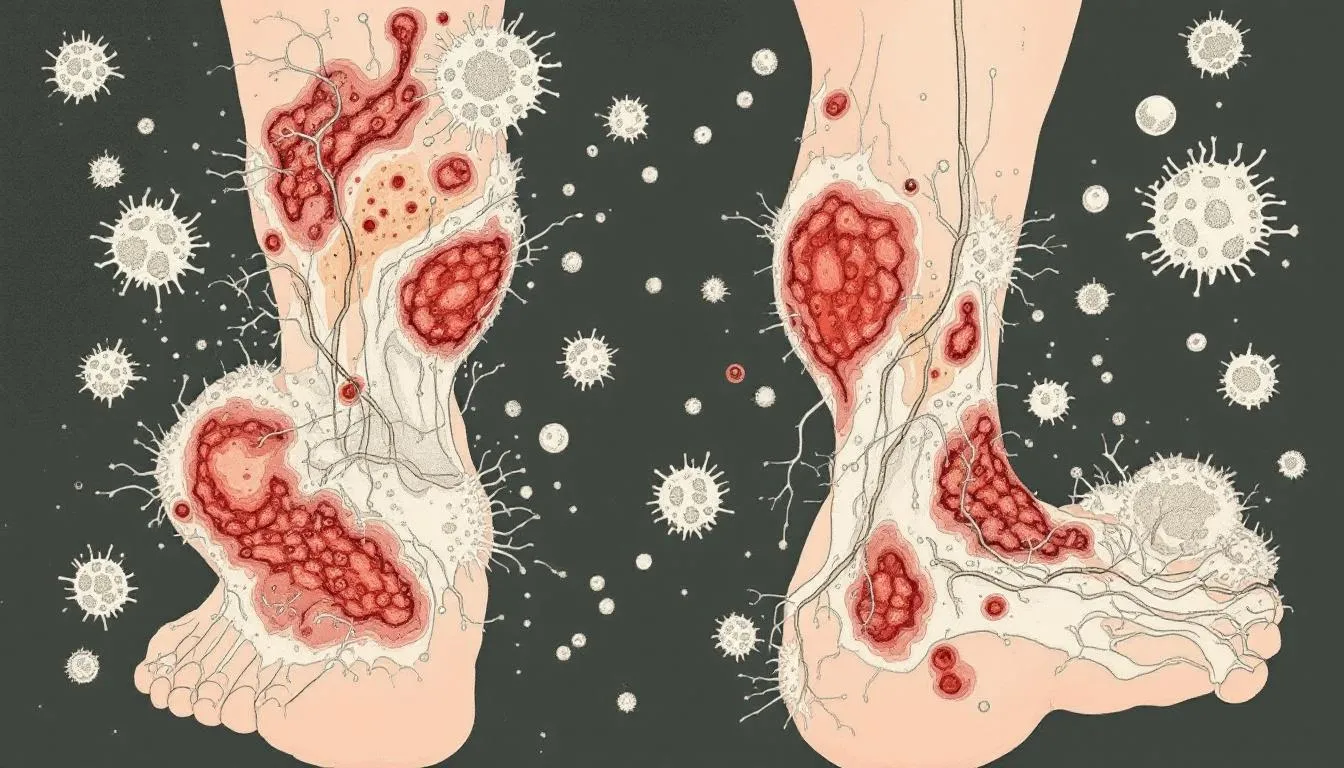
Chronic exposure to mold can lead to ongoing inflammation, exacerbating symptoms over time. This low-level inflammation contributes to muscle and joint discomfort, making it difficult for the body to heal and recover. Individuals exposed to mold may experience increased levels of inflammation, which can worsen conditions like arthritis and heighten pain and discomfort.
The immune system’s response to mold can lead to elevated cytokine levels, which are linked to increased joint inflammation and pain. This chronic inflammation can interfere with the body’s natural healing processes, prolonging joint and muscle pain. For sensitive individuals, chronic mold exposure can significantly impact their quality of life, leading to persistent health issues and discomfort.
Addressing chronic inflammation requires a comprehensive approach, including reducing mold exposure and supporting the body’s inflammatory response. By minimizing exposure to mold spores and implementing effective mold remediation strategies, individuals can reduce inflammation and find relief from joint pain and other symptoms.
Recognizing Symptoms of Mold-Related Joint Pain
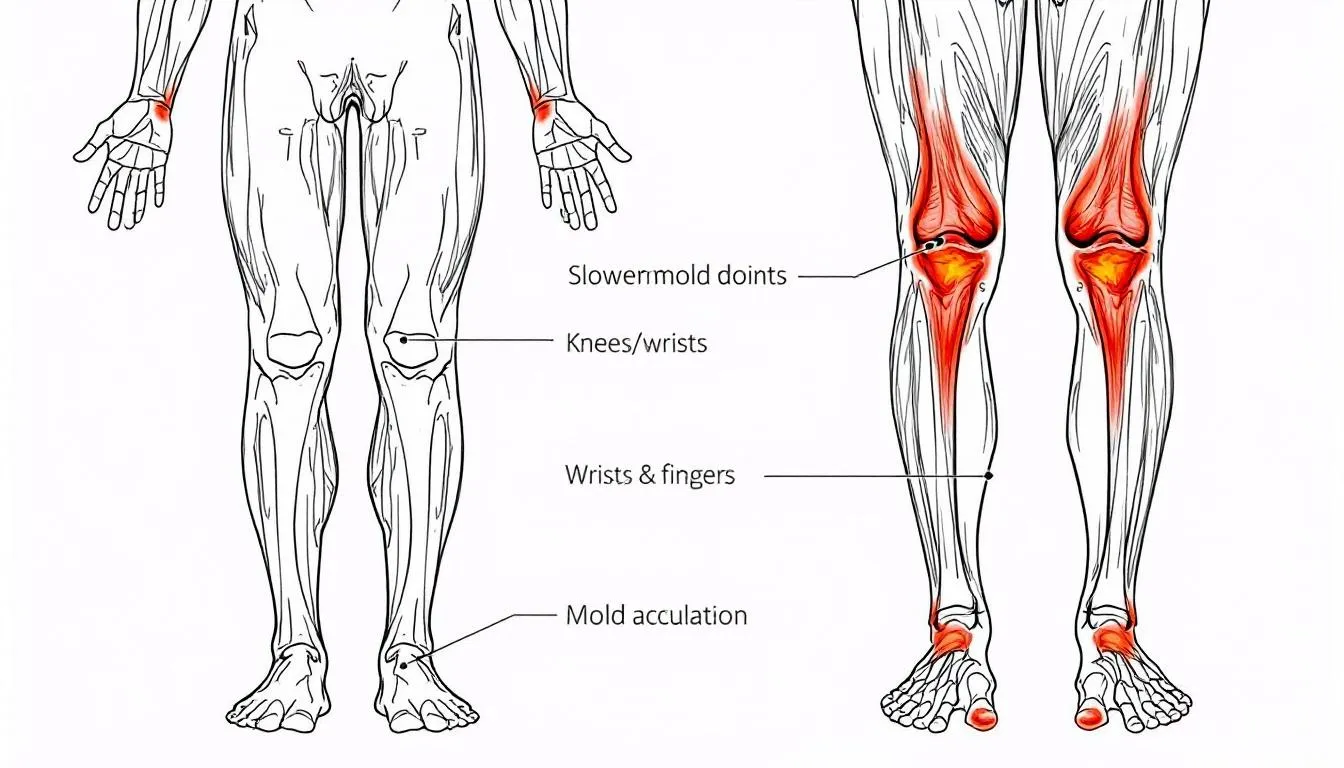
Recognizing the symptoms of mold-related joint pain is crucial for early intervention and treatment. Joint pain linked to mold exposure often presents as:
Persistent pain that can shift between different joints
Visible swelling around the joints
Redness around the joints, indicating an inflammatory response to mold mycotoxins
In addition to joint pain caused, individuals may experience:
Increased stiffness, particularly in the morning or after extended periods of inactivity
Persistent fatigue
Weakness
Decreased mobility
Rheumatoid arthritis
Multiple chemical sensitivity: heightened sensitivity to various environmental chemicals, fragrances, and odors
These symptoms may accompany mold-related muscle and joint pain, further affecting daily activities and overall well-being.
If you suspect mold exposure and experience persistent symptoms like ongoing headaches, joint pain, or memory problems, it is essential to consult a healthcare provider. Early diagnosis and treatment can help manage allergy like symptoms and prevent further health complications.
Brain Fog and Memory Problems from Mold Exposure
Mold exposure doesn’t just affect the body physically—it can also have a profound impact on cognitive function. Many people exposed to mold toxins report experiencing brain fog, a frustrating condition marked by difficulty concentrating, forgetfulness, and mental fatigue. These symptoms of mold toxicity can make it challenging to focus at work, remember important details, or even carry on conversations, affecting both productivity and quality of life.
The underlying cause of these cognitive issues is often the inflammatory response triggered by mold toxins. When the nervous system is exposed to these harmful substances, it can lead to ongoing fatigue, mood swings, and memory problems. Recognizing symptoms such as persistent brain fog, trouble recalling information, and changes in mood is crucial for early intervention.
Effective treatment for brain fog and memory problems caused by mold exposure involves reducing contact with mold, supporting brain health through proper nutrition and rest, and adopting cognitive enhancement strategies. By addressing the root cause—mold toxicity—individuals can begin to restore their cognitive function and improve their overall well-being.
Central Nervous System and Mold Toxicity
The central nervous system (CNS) is particularly sensitive to the effects of mold toxicity. Mold toxins, especially mycotoxins, can disrupt the normal functioning of the nervous system, leading to a range of neurological symptoms. These may include persistent headaches, unexplained seizures, and movement disorders such as tremors or difficulty with coordination.
When mold exposure occurs, these toxins can interfere with the communication pathways in the brain and spinal cord, sometimes resulting in CNS infections or inflammation. Because the central nervous system controls essential functions like movement, balance, and reflexes, any disruption can have serious consequences for daily life.
If you notice symptoms such as severe headaches, sudden seizures, or changes in movement after mold exposure, it’s important to seek medical attention promptly. Reducing mold exposure and addressing any underlying health conditions are key steps in preventing further CNS damage and managing neurological symptoms linked to mold toxicity.
Digestive Issues and Mold Toxicity
Digestive issues are another common but often overlooked consequence of mold exposure. Mold toxins can irritate the gastrointestinal tract, leading to symptoms such as nausea, abdominal pain, diarrhea, and bloating. The body’s inflammatory response to these toxins can disrupt the balance of gut bacteria, resulting in changes in appetite, food intolerances, and even nutrient malabsorption.
Chronic inflammation from ongoing mold exposure can contribute to more serious digestive problems, including leaky gut syndrome and irritable bowel syndrome (IBS). These conditions not only cause discomfort but can also increase the risk of recurrent infections and further compromise overall well-being.
Managing digestive symptoms related to mold toxicity involves reducing exposure to mold, adopting a gut-friendly diet, and considering supplements that support digestive health. Addressing these issues is essential for maintaining overall well-being, as persistent digestive problems can significantly impact quality of life and contribute to chronic inflammation throughout the body.
Other Health Issues Linked to Mold Toxicity
Mold toxicity can lead to a variety of health issues beyond joint pain. Cognitive function difficulties, such as difficulty concentrating, memory problems, and brain fog, are frequently associated with mold exposure. Mood disorders such as depression and anxiety are also linked to mold toxicity, as exposure can cause mood changes through inflammation and neurotransmitter imbalances. Chronic fatigue is another common symptom, impacting overall well-being and daily functioning, including mold illness. Symptoms of mold illness can sometimes be misdiagnosed as chronic fatigue syndrome due to their similarity, making specialized knowledge important for accurate diagnosis.
Respiratory issues, such as coughing, wheezing, shortness of breath, and chest tightness, can also result from mold exposure and are often associated with respiratory disorders. Additionally, digestive issues, including nausea, vomiting, diarrhea, and abdominal discomfort, are linked to mold toxicity. These symptoms further highlight the wide-ranging impact of mold exposure on overall health.
Mold exposure can also affect the nervous system, potentially triggering heightened sensitivity and other neurological conditions symptoms due to environmental triggers. Addressing these health issues requires a comprehensive approach to mold remediation and reducing exposure, as well as seeking appropriate medical treatment.
Importance of Mold Testing and Diagnosis
Diagnosing mold exposure can be challenging due to the wide range of symptoms that often mimic other health issues. Tools like the Dampness and Mold Assessment Tool (DMAT) are useful for evaluating moisture and mold-related damages in buildings, helping to identify potential sources of mold exposure. HVAC systems can harbor and distribute mold spores throughout indoor environments, especially if not properly maintained, making them an important factor to consider during inspection and testing.
If you suspect mold growth in your home, it is crucial to reach out to professionals for assistance. SafeAir Certified Mold Inspection Inc. specialize in addressing indoor environmental contaminants, including mold, and can provide comprehensive solutions to ensure a safe and healthy indoor environment.
Effective mold testing and diagnosis are essential steps in managing and preventing mold-related health issues. By identifying and addressing mold growth early, you can reduce exposure and mitigate the impact on your health.
Effective Treatment and Prevention Strategies
Managing joint pain linked to mold toxicity requires a multifaceted approach. Reducing mold exposure is crucial to support natural healing and alleviate symptoms. Natural remedies, such as turmeric, ginger, omega-3 fatty acids, and Epsom salt baths, can help reduce inflammation and provide relief from joint pain.
Professional solutions offered by companies like SafeAir can help create a safe and healthier indoor environment. For tailored treatment plans, contacting experts like Infinity Wellness Telehealth can provide personalized strategies to manage mold-related joint pain and improve overall well-being.
Implementing effective treatment and prevention strategies is key to achieving lasting relief from mold-related health issues. By addressing the root cause and supporting the body’s healing processes, individuals can improve their quality of life and prevent further complications.
When to Seek Medical Attention
Seeking medical attention is crucial for individuals experiencing severe symptoms related to mold exposure. Those who should seek immediate medical assistance include:
Individuals with severe neurological symptoms, such as seizures or significant mood changes
Individuals with a history of respiratory issues
Individuals with weakened immune systems who suspect mold exposure
If unusual symptoms arise after potential mold contact, it’s important to:
Contact a doctor to rule out mold toxicity and other health issues.
Have healthcare professionals perform specialized tests to determine if mold exposure has led to an allergy or other health problems.
Seek medical attention if warranted based on test results.
Early intervention and diagnosis can help manage symptoms and prevent further health complications by addressing the underlying causes. Recognizing the signs and seeking medical care when needed is essential for maintaining overall health, well-being, and effective symptom management.
Creating a Mold-Free Home
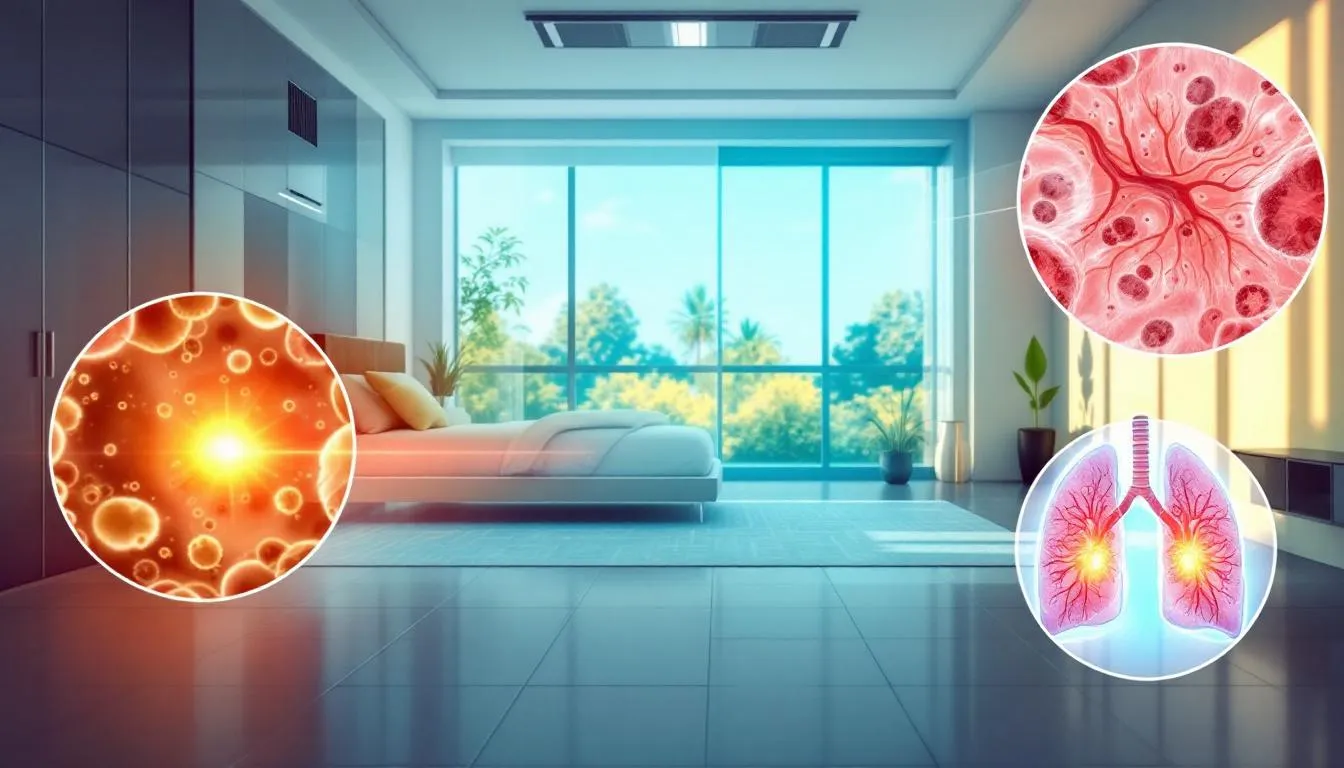
Creating a mold-free home is essential for preventing mold-related health issues. Key points to consider include:
High humidity levels above 60% create ideal conditions for mold growth, increasing exposure risk.
Maintaining indoor humidity below 50% is essential to prevent mold growth.
Managing indoor humidity effectively can also help manage joint pain.
Practical steps to reduce moisture levels and prevent mold growth include:
Using exhaust fans during moisture-generating activities
Ventilating appliances to the outside
Improving overall ventilation in the home
Regular maintenance of gutters
Ensuring proper drainage around the foundation to prevent moisture accumulation
To reduce mold spores in the home and prevent health issues, consider the following:
Use mold-resistant materials during home renovations.
Regularly clean with natural antifungal cleaners.
Address mold growth promptly, especially if it stems from water damage.
Summary
The connection between mold exposure and joint pain is often overlooked but is crucial to understand for effective symptom management. Mold toxins can lead to inflammation and a variety of health issues, impacting overall well-being. Recognizing symptoms and seeking appropriate treatment are essential steps in managing mold-related joint pain.
Effective mold testing and professional assistance are critical in identifying and addressing mold growth. Implementing prevention strategies and creating a mold-free home can significantly reduce exposure and improve health outcomes. By taking proactive steps, individuals can protect themselves and their loved ones from the harmful effects of mold toxicity.
In conclusion, understanding the impact of mold exposure on joint pain and overall health empowers individuals to take control of their environment and well-being. With the right knowledge and strategies, it is possible to live a healthier, mold-free life.
Frequently Asked Questions
Can mold exposure really cause joint pain?
Yes, mold exposure can indeed cause joint pain by triggering an inflammatory response from mycotoxins, which affects muscles, joints, and connective tissues. This can result in persistent pain and discomfort.
What other health issues are linked to mold toxicity?
Mold toxicity is linked to various health issues such as cognitive difficulties, chronic fatigue, respiratory problems, gastrointestinal disturbances, and neurological symptoms. Addressing mold exposure promptly is essential for preserving overall health.
How can I test for mold in my home?
For accurate diagnosis of mold in your home, it is advisable to engage professional mold testing services. Utilizing tools like the Dampness and Mold Assessment Tool (DMAT) can assist in evaluating moisture and mold-related damages effectively.
What are some natural remedies for mold-related joint pain?
Turmeric, ginger, omega-3 fatty acids, and Epsom salt baths are effective natural remedies that can help reduce inflammation and alleviate joint pain linked to mold toxicity. It is advisable to incorporate these remedies into your routine for better relief.
When should I seek medical attention for mold exposure?
You should seek medical attention for mold exposure if you experience severe neurological symptoms, respiratory issues, or any unusual symptoms, especially if you have a history of allergies or respiratory conditions. Prompt consultation with a healthcare provider is essential in these cases.

